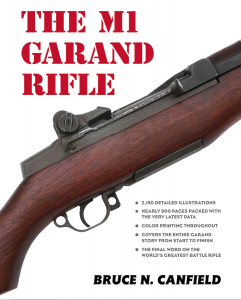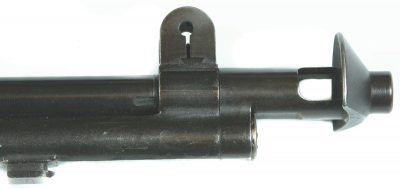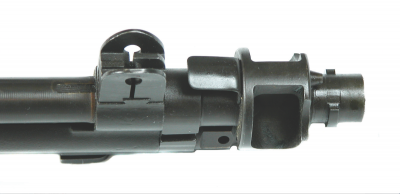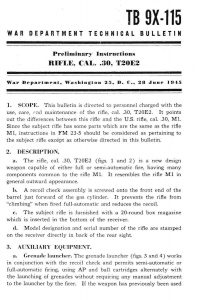
John Garand’s first selective-fire prototype, attempting to up the firepower of the classic battle rifle. Image courtesy of Bruce N. Canfield.

Bruce N. Canfield’s book, “The M1 Garand Rifle,” published by Mowbray Publishers, is the source of the interesting material in this article. To learn more, pick up your own copy of the 872-page tome.
To learn more, visit https://gunandswordcollector.com/Templates/book%20pages/canfield_M1garand.html.
To purchase an M1 Garand on GunsAmerica.com, click this link: https://www.gunsamerica.com/Search.aspx?T=m1%20garand.
Editor’s Note: This piece is an abridged excerpt from the book The M1 Garand Rifle by Bruce N. Canfield. If you would like to explore this subject in greater detail, you can obtain a copy of the 872-page book from Mowbray Publishing, 54 East School St., Woonsocket, RI 02895.
During World War II, the Ordnance Department granted a number of developmental contracts for various types of weapons. These weapons were given a “T” (Test) prefix and were intended either to modify the existing M1 rifle to increase its utility or were an entirely different type of weapon that might prove to be an improvement over the Garand.
The Springfield Armory T20 and variants — a Glimpse at the Future
Early in World War II, it was seen that an M1 rifle capable of selective-fire (semi-automatic and fully automatic capability) could be a notable improvement over the standard semiautomatic-only rifle with a limited (eight-round) magazine capacity. To this end, there was a great deal of interest in the possibility of developing a selective-fire, detachable-magazine weapon based on the Garand rifle. Firearm designers soon ran into the same problem that had caused much consternation back in the 1920s and early 1930s when John Pedersen and John Garand were working on their semiautomatic rifles. The problem encountered then was the proper cartridge for a semiautomatic rifle. One of the strong arguments in favor of Pedersen’s reduced-caliber .276 cartridge was that the smaller bullet did not generate as much heat when firing semiautomatically as did the larger .30-caliber cartridge. As gun engineers studied the concept of a selective-fire Garand in the early 1940s, the heating problem again arose, but this time it was greatly magnified when full-automatic fire was factored into the equation. Also, the Garand’s limited eight-round magazine capacity hampered effective use of such a weapon when firing in the full-automatic mode.

Shown is the T20 selective-fire rifle, John Garand’s first “T”-variant rifle. Image courtesy of Frank Iannamico.
As indicated by a May 1942 Springfield Armory report, John Garand was developing a selective-fire version of his rifle fitted with a BAR barrel and capable of being used with the BAR’s 20-round detachable-box magazine. The above-referenced heating problem was evident in a Springfield Armory report, which stated that, because of the large capacity magazine, “…problems could well arise due to overheating and cook-off.” It was also reported that Mr. Garand discovered that the additional force required to strip cartridges from the extended magazine resulted in increased friction. The project seems to have been put on the back burner for a couple of years due to more pressing matters, as there are only a few sporadic reports on further development of the design later in 1942 and for most of 1943.In early 1944, however, the project was resurrected and became the focus of a great deal of attention by Springfield Armory. As related by R. Blake Stevens in his marvelous book
In early 1944, however, the project was resurrected and became the focus of a great deal of attention by Springfield Armory. As related by R. Blake Stevens in his marvelous book U.S. Rifle M14 — From John Garand to the M21:

View of T20 rifle fitted M1 bayonet and M81/82 telescope. The weapon was designed to be compatible with items previously standardized for the M1 rifle. Image courtesy of SANHS/NPS.
“Reports on the initial trials of the 20-shot M1 model, already made up as mentioned…by John Garand in response to the Ordnance Department’s 1942 request, had noted that the rifle was particularly sensitive to feeding while on automatic fire. With the heavy column of cartridges in the 20-round BAR magazine, the relatively light M1 bolt did not stay open long enough for the cartridges to rise sufficiently to present the base of the leading round for feeding, and as a result the rifle jammed. John Garand reported that either the magazine and its spring had to be redesigned to make its action stiffer, thus losing the desirable feature of interchangeability with the BAR and increasing breech mechanism friction even more, or the rear portion of the M1’s receiver had to be lengthened slightly. This would allow the bolt to recoil farther, thus giving the stack of cartridges in the magazine more time to rise. (In what seemed like the ‘good old days,’ a jamming problem attributable to the same source had been encountered in a rifle design by a Lt. Hawkins back in 1910. The problem was overcome by simply shortening the cartridges!). No such option was open to John Garand in 1944.”

Shown is serial number 8 T20 rifle. The rear sight is believed to be an experimental Bennel model. Image courtesy of Frank Iannamico.
The Ordnance Department’s relatively new policy of utilizing Springfield Armory for extensive research and development work, in addition to its traditional role as a manufacturer, was one of those things that sounded good in theory but did not always work out so well in practice. Additionally, the requirements of the using services and the realities of small arms design and production could often conflict. The development of a selective-fire Garand vividly highlighted both conflicts.
The T20
Despite the above challenges, the Ordnance Department’s Technical Committee recommended that Springfield Armory proceed posthaste with the development of a selective-fire version of the M1 rifle fitted with a detachable-box magazine. The weapon was designated as the T20. One of the first issues to tackle was the feeding problems encountered with the 20-round BAR magazine. The difficulty was one of simple physics. A stack of 20 cartridges is heavy and, therefore, rather difficult to lift into the path of the bolt. John Garand championed lengthening the receiver, which was ultimately the option selected.

The T20 had a distinctive muzzle brake design to help control recoil under fire. Image courtesy of Frank Iannamico.
A September 1944 Springfield Armory report noted: “Initial trial model of the T20 has been started in this shop. Receiver length will be longer than that of the M1 rifle… Data are being assembled on time intervals involved in feeding in…selected…slow and fast M1 rifles.”
Although the Springfield Armory production staff was strongly in favor of keeping the original M1 rifle design as unchanged as possible, each subsequent permutation of the new weapon resulted in the basic M1 action being further altered.
The initial design was intended to permit semiautomatic fire from a closed bolt (as with the standard M1 rifle) and automatic fire from an open bolt (as with the BAR and most other automatic weapons). However, the Aberdeen testing concluded that, while theoretically desirable, such a mechanism was impractical and this requirement was dropped. It should be noted that one of the few WWII-era selective-fire weapons that successfully employed both closed-bolt (for semiautomatic operation) and open-bolt operation (for fully automatic operation) was the Johnson Light Machine Gun.
In any event, these issues, plus the necessity to redesign some parts to increase their strength, resulted in the T20 being superseded in January 1945 by the T20E1.

The T20E1 variant of the T20 series incorporated incremental improvements over the T20 rifle. Note the heel of the slightly redesigned receiver. Image courtesy of Frank Iannamico.
The T20E1
The book U.S. Rifle M14 — From John Garand to the M21 contains the following summation of the T20E1 tests at Aberdeen Proving Ground:
“At the Aberdeen T20 trial, excessive flash, recoil, muzzle blast and climb were reported. Overheating on rapid fire was a problem, and the open-bolt full auto feature did not materially reduce the incidence of cook-off. In addition, the timing of this open-bolt device was found to be in question, as, depending on when the firer released the trigger, the action might come to rest with the bolt open or closed. Nevertheless, a hard-pressed, wartime Aberdeen Proving Ground concluded that the basic principle of operation was satisfactory, admitting that the ‘noted feed failures were due mainly to battered and deformed BAR magazines.’ They recommend certain specified, relatively minor changes, and the strengthening of various components, saying that these modifications should be undertaken immediately.”

The T20E1 had a new muzzle brake design developed to help control excessive muzzle blast and flash. Image courtesy of Frank Iannamico.
After reviewing the results of the recently concluded Aberdeen testing, the Ordnance Technical Committee determined that some of the initial requirements desired for the proposed new weapon such as firing from an open bolt, a folding stock and short barrel (the latter two features for airborne use) were impractical or unnecessary. After evaluating the reports of the testing, John Garand began work on incorporating the various recommended revisions into an improved version of the weapon designated as the T20E1. The new design was evaluated, and the results were sufficiently encouraging to result in ten rifles being fabricated for further testing, including limited troop trials after which another 100 examples were to be manufactured. The Ordnance Department publication Record of Army Ordnance Research and Development, 1946, compiled under the direction of Col. R.R. Studler, contained the following regarding the T20E1 rifle:
“The T20E1 Rifle, incorporating the changes desired as a result of testing previous models, fired both automatic and semi-automatic from a closed bolt, omitting the unsatisfactory feature for holding the bolt open on automatic fire and substituting in lieu thereof two heat flow arresting grooves on the barrel before the chamber for chamber cooling. In addition, the receiver was further modified to simplify the operation of locking the receiver and trigger group together as well as to introduce a more secure means of locking the box magazine within the magazine well. At the same time, the receiver was prepared to mount a telescopic sight, night sight, or grenade launcher sight, as might be desired. The recoil check was modified to take a bayonet. However, the T20E1 was still incapable of mounting a grenade launcher or flash hider. A new box magazine to replace the modified BAR magazine was developed to work in conjunction with the new method of locking in the receiver, and thus this magazine provided the only means of holding the bolt to the rear in its retracted position. This magazine was not interchangeable for use in the BAR.
The T20E1 Rifle mounted an adjustable bipod from the gas cylinder but this bipod was not readily removable.
During the period of 22 through 26 January 1945, the T20E1 Rifle was tested at the Ordnance Research Center, Aberdeen Proving Ground. This model was complete in all details, and the test results, other than the failures to feed, were exceptional. These failures to feed were caused by the bolt bearing surface in the barrel being soft. The following minor changes and improvements were authorized to be incorporated in the 10 Rifles T20E1 to be fabricated for service test:
• Induction harden the breech end of the barrel.
• Increase length of the bipod to permit greater command height.
• Redesign the gas cylinder and gas cylinder lock screw assembly to permit ready attachment and removal of rifle accessories.
• Improve the handguard to prevent charring.”

The T20E2 took everything that had been learned through the T20E1 model and adapted it to address those concerns. Image courtesy of Frank Iannamico.
The T20E2
After the above improvements were incorporated into the design, the revised T20E1 rifle was tested further by the Infantry Board and the U.S. Marine Corps Equipment Board. These tests resulted in several additional recommended changes, which were significant enough to warrant a re-designation of the weapon to “T20E2.” The Army Ordnance R&D Record for Fiscal Year 1946 contained details of the recommended changes and the order for the new designation:“Further tests of the T20E1 Rifle by the Infantry Board and the Marine Corps Equipment board resulted in the incorporation in the T20E2 Rifle of the following improvements:
“Further tests of the T20E1 Rifle by the Infantry Board and the Marine Corps Equipment board resulted in the incorporation in the T20E2 Rifle of the following improvements:
- Magazine to be useable in the B.A.R.
- Magazine catch to be altered in shape to eliminate the possible hazard of being accidently depressed or damaged during rough handling.
- Provision for means of retaining the operating slide in the rear position in order that the rifle might be cleaned in the prescribed manner.
In view of the favorable test results and simplicity of design of the T20E1 Rifle, Springfield Armory was instructed to fabricate 100 models incorporating the above changes for the extended service test. This definitive design was designated as Rifle, Caliber .30, T20E2.”An April 1945 Springfield Armory report confirmed the orders to fabricate the 100 new rifles incorporating the above-enumerated changes as well as the project’s “high priority” status:
An April 1945 Springfield Armory report confirmed the orders to fabricate the 100 new rifles incorporating the above-enumerated changes as well as the project’s “high priority” status:
“Nine additional models of the T20 Rifle have been completed and eight shipped in accordance with instructions from…(the Ordnance Department)… Work on this project continues to receive the highest priority in the Model Shop. It is understood that on completion of tests of the T20E1 at Ft. Benning a conference will be held at the Armory with representatives of (the Ordnance Department), Army Ground Forces and Ft. Benning to discuss proposed changes to be incorporated into the T20E2 model. It is anticipated that as a result of the Benning tests, modifications will be made to some components now in process for the order of 100 rifles.”
Production plans for the selective-fire (T20E2) revealed some important and subsequently influential assumptions. First, and foremost, Armory engineers insisted that 85 percent of the standard production tooling for the M1 rifle could be used in the fabrication of the (T20E2). In other words, they believed that it would be relatively easy to manufacture the T20E2. Furthermore, they insisted that it would not be much more expensive to manufacture than the M1. An Ordnance Technical Committee estimate suggested that the new rifle would be only slightly more costly than its predecessor. With all of this said, it was estimated in May 1945 that deliveries of the (T20E2) would not begin until January of the next year because it was ‘a new experimental gun that had never been made.’
When the Japanese resistance ended, the selective fire rifle project was still far from completion. While the cessation of hostilities did not spell the immediate end of the T20 project, it did eliminate any sense of urgency. Post-war work on the selective M1 rifles was limited to completion and testing of the designs. Army Ground Forces personnel decided to support the completion of the projects to modify the M1 rifle for selective fire. They did so merely to obtain a full evaluation of the two designs.

Bruce N. Canfield’s book, “The M1 Garand Rifle,” published by Mowbray Publishers, is the source of the interesting material in this article. To learn more, pick up your own copy of the 872-page tome.
Conclusion
Unlike many small arms development projects, the end of World War II did not result in the T20 being cancelled. The urgency to refine and adopt an improved service rifle was gone but Ordnance remained committed to such a goal. Improved variants of the T20 were introduced after 1945 and continued to be developed at varying levels in the 1950s. Ultimately, the United States would settle upon the M14 rifle as the successor to the M1 Garand. However, the T20 makes for an interesting insight into the efforts to modernize and update the classic M1 Garand rifle and likely helped lay the groundwork for the M14.
Editor’s Note: This piece is an abridged excerpt from the book The M1 Garand Rifle by Bruce N. Canfield. If you would like to explore this subject in greater detail, you can obtain a copy of the 872-page book from Mowbray Publishing, 54 East School St., Woonsocket, RI 02895.
To learn more, visit https://gunandswordcollector.com/Templates/book%20pages/canfield_M1garand.html.
To purchase an M1 Garand on GunsAmerica.com, click this link: https://www.gunsamerica.com/Search.aspx?T=m1%20garand.



i had a m1 in itr marine corp 1967 had a 3006 round loaded from bottom magazine 8 or 10 rounds
what modal was it ?
The M1 Garand uses an 8 round “Clip” Not a Magazine….Anyone going to get all butt hurt about the term “Magazine” being used in the article?
My father said some of the guys in his unit (87th Mountain Inf. Regiment.) turned their Garands into full auto (very easy to do) during some down time on Kiska in 1943 , then after the fun wore off, visited the armorer for a new trigger group. or more specifically for a new replacement trigger and sear that somehow became “worn down”.
Spotty editing. Otherwise tolerably written and informative.
Interesting insights into how the US War Dept conducted small arms R&D, in those days.
30-06 was the longest military rifle cartridge ever made: worked OK in bolt actions, and heavy machine guns, but was too long, too spindly, too powerful for self-loading shoulder rifles and light machine guns. Gen MacArthur’s decision to drop 276 Pedersen was not his best.
Weapon system development always demands compromises. This is not widely understood inside the military; among civilian gun enthusiasts, it’s even less well-understood. Or perhaps everyone is reluctant to accept unhappy truths.
Very poorly written article. Why all the repeats? Bruce Canfield is so far behind what is really going on it’s funny. Re hash of his hash. This is in effect an advertisement for Bruce Canfield. I am biased as his books and so called research is not up to par with the modern professionals. To all those who did not know of the T20 eta al I am glad you do now. Seek out better material.
OK a$$hole, what are the titles of the books YOU have written on the Garand? Go on, lay it out here in public what all of your qualifications are for bad-mouthing one of the leading experts on the Garand rifle. Go on, we’re waiting.
Spoken like a true internet troll!
Interesting article. Seems I read somewhere about some creative soldiers who were able to modify the Garand to shoot full auto.
The bolt didn’t have enough weight to go back far enough. Increase the weight of the bolt. Add extra mass in out-of-the-way areas.
Never understood why the M1 wasn’t modified to take BAR magazines. If a BAR
If a BAR gunner shouts, “Hey! I need a magazine!” He’d be buried in mags. 🙂
A full auto 30.06 Garand? You could probably replicate that experience by lighting a rodeo bull on fire and then grabbing one of his hind legs.
I agree-no matter how much the idea or sight of a fully-auto M1 Garand may get my man-parts all aquiver, there’s no way I’d be able to control a rifle like that after the first round goes down range. She sure is purdy, though!
The 762x51mm NATO aka .308 Winchester has almost the same recoil and ballistics as the 30-06 and was used in the M14 which is select fire.
Uh, why not just increase the number of B.A.R.’s per unit?!?!?!?!
Six of one, half a dozen of the other.
That’s all they accomplished, a slightly different B.A.R. with headaches.
The BAR was a big heavy beast of a rifle, carrying it and the amount of ammo it could spit out would take a soldier akin to a large plow horse compared to the soldier needed to carry the Garand and it’s clips of ammo.
There was no time to build up a different round in enventory in WW2 so this why not copy the German MP42 which could use the 30-06 which has lighter power than its 8mm counterpart and lighter than the bar???
.
I love the Internet for its ability to bring obscure info and technology to the attention of those who seek it out.
Cool.
.
Very interesting reading over my morning coffee. I always wondered why the change to .308 was enacted given the vast supply of 30-06 on hand. The Garand was the rifle that changed the battlefield forever.
No, the the need for something larger than a submachine gun on the Eastern Front changed the battlefield forever. Hence the STG44 and then the AK-47. The Garand is a post WWI designed WWII relic. The US was just playing slow catch up since it was never involved in the heaviest urban fighting. Also, since no one was attacking US borders, the leadership was obviously not in hurry.
The AK47 wasn’t in use in during WW 11. It was developed in 1945 , and the venerable STG 44 was Germany’s development during WW 11. The average German trouper used a bolt action mouser. The M 1 Garand entered service in 1936. and it was the semi auto rifle that changed the battlefield forever.
It’s a matter of opinion, and as you know everyone has one. Only my opinion being made by historical facts stinks less of asshole butter than yours.
Billy bob,
I didn’t see anywhere mentioned it was a 308 round… Someone correct me if I’m wrong but Garands were all 30.06 until 1957 when military adopted M14 they went to nato round.
308 was developed around 1952…I think.
.
The US Navy had some M1s modded to .308 ’til M14s arrived.
Would have been easier to just stock more 30.06 aboard ship.
.
Of course, the Italians got around a lot of the problems mentioned above by simply rechambering the M1 for 7.62 x 51 NATO, when they modified the Garand into the BM-59…
650 rpm 60 seconds in a minute = 10.83 per second 20 round magazine empty is less than 2 seconds !
308 Weight per 100 rounds (lbs): 5.35 * 6.5 =34.775 weight for just one minute of firing
one shot one kill or mult shots one kill plus having to take time for a mag change ! (if you are quick you may get 3 maybe 4 bursts) You best hope your targets are in a tight group ! I didn\’t even talk about the muzzle rising up after EACH SHOT !
Water cooled or quick change barrels with end less supply of ammo is hard to beat !
Like they say down range today (for opposite reason)– 1 mag=1 kill…